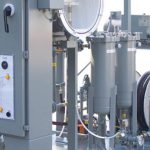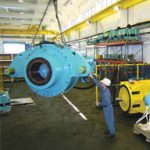When John C. Lincoln founded The Lincoln Electric Company in 1895, he did so with a capital investment of $250 and with the sole purpose of manufacturing the electric motors that he’d designed. Before long its product line had grown to include battery chargers for electric cars, and it made its first welding set in 1907. Four years later, in 1911, the company introduced the world’s first variable voltage, single operator, portable welding machine. Today it leads in the design and manufacture of arc welding products, robotic welding systems, and plasma and oxyfuel cutting equipment. The company’s structure has drawn plenty of attention, as well, resulting in two case studies published by the Harvard Business School.
“John Lincoln was a true genius, and he wanted to spend his time conducting research and developing new products, so he handed the company’s reins over to his brother James in 1914,” according to Patrick Wahlen, global business segment director for the power generation industries. “James was the one responsible for introducing piecework pay and he also established our Employee Advisory Board, which is made up of elected representatives from every department. Soon after he provided group life insurance to all the company’s employees, which was very progressive for its time.”
This spirit of innovation has driven Lincoln Electric ever since, resulting in the development of additional policies that have drawn the attention of Harvard business students and others. Headquartered in Cleveland, Ohio, with 38 manufacturing facilities in 18 countries around the world—and sales offices covering more than 160 countries—its U.S. operations practice profit sharing among its employees, also guaranteeing job security to anyone who remains with the company for at least three years.
“This results in a ‘self-policing’ workforce, since your bonus depends on your coworkers doing a good job, too,” Wahlen explains, “and fewer managers are required to oversee their activities. It also leads to phenomenal employee retention, which allows us to retain the experience our workers have gained over the years.”
Lincoln Electric is able to provide similar efficiencies to its customers, particularly those involved in manufacturing towers for the wind industry. Harnessing its welding products with its knowledge of both processes and materials, the company has been able to increase productivity in its customers’ manufacturing facilities by 50 percent, and sometimes as much as 100 percent. “The price of our products must be competitive, of course,” he says, “but we would rather help our customers cut their production costs by 10 percent than discount the cost of a piece of equipment by the same amount. That’s where the real savings are found, and that’s not a one-time deal. These savings are ongoing.”
As a recognized expert in submerged arc welding, which is the process primarily utilized in the manufacture of wind tower sections, Lincoln Electric has been able to claim a 60-70 percent market share of new welding equipment sold into the global wind industry in recent years. Due to the quality of its products, this growth is also supported by the host of services it provides to its customers. The Lincoln Electric Welding School offers courses throughout the year on various arc welding methods, and its Welding Technology Center performs professional seminars on topics including the fundamentals of weldment design and advanced subjects such as fracture mechanics and fatigue. In addition, the company has more than 200 field technicians in the Unites States alone, helping clients to achieve maximum efficiency and gathering insights that will guide future product development.
“We are committed to engaging our customers in a very real way, using our products and expertise to deliver solutions to the challenges they face in meeting their manufacturing goals,” Wahlen says. “It’s a model that we’ve relied on for more than a century now, and it hasn’t failed us yet. More importantly, it hasn’t failed our customers.”–R. W.
To learn more:
Go online to www.lincolnelectric.com.








































